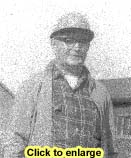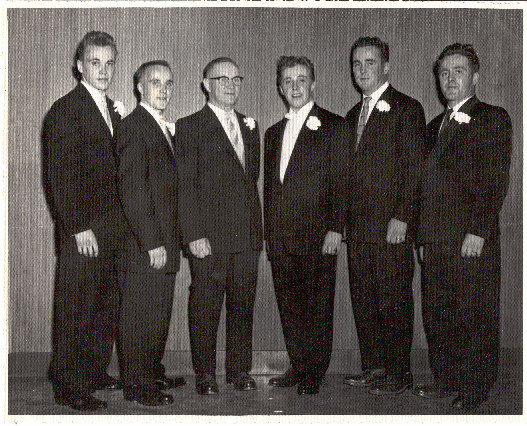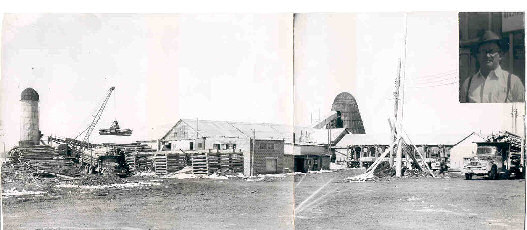


| Originally from Sweden, Henry Selin arrived in Canada with his family when he was only 13 years old. They settled in Sault Ste. Marie. | ||
 |
||
|
From left to right: Arthur, Jack, Henry, Bob, Clifford and William Selin (Écomusée de Hearst et de la région collection; picture donated by Mr. Arthur Selin) |
||
| Henry
first got involved in the forest industry as a pulpwood contractor for
the Abitibi Paper company. He then arrived in Hearst in 1944 as a major
pulpwood contractor for Marathon Paper. He operated camps located about
50 kilometers (30 miles) west of Hearst.
In 1947 he purchased the Queen's Hotel in Hearst. The same year, he bargained with Transcontinental Timber to establish a sawmill on townships he held west of Hearst and, in 1948, a mill and a forestry village were built at Nassau Lake. He also built more sawmills and lumber camps in the forest. |
||
 |
||
|
(picture donated by Mr. Réginald Veilleux) |
||
| Henry
Selin got help from his sons, namely Clifford (sawmill and general operations),
William (forestry operations), Jack (maintenance) and Bob (planer and sales).
Before
the arrival of utility services in the area in the mid-60s, Nassau Lake's
main camp depended on diesel-powered generators to produce electricity.
There were houses for 55 families, camps for 100 workers, a school/church,
a general store, a recreation room with bowling allies and pool tables,
a television reception tower, garages and warehouses.
It was, at that point in time, the most important sawmill in the region, as noticed by Paul Zorzetto who arrived in 1955 to work as a lumberjack after answering a request for manpower in the Journal de Montréal. "The company operated the first large sawmill in the North. It sawed 150,000 feet per 10 hour shift. The sole operation of the mill required 55 men per shift" (Excerpt from an interview with Paul Zorzetto, Le Nord, September 1, 1976). In the late 1950s, the Henry Selin Forest Products mill was, according to many observers, the most important sawmill in Eastern Canada, with an annual production of 50 million feet of lumber. The Selin mill could count on three saw lines while most other sawmills only benefited from one. Furthermore, the company innovated in many domains, for example becoming the first in the region, and probably in Ontario, to install and operate a chipper to make and sell wood chips. Hundreds of men worked in the forest, along with more than 200 horses before the mechanization of forest operations. In this latter domain Henry Selin Forest Products acted as a pioneer, introducing tractors, trucks, skidders and cranes before many others. Trucks carried lumber to the Selin planer in Hearst, along Highway 11 West. Wood chips, meanwhile, were loaded in Wyborn on Algoma Central train cars and shipped to the Marathon and Domtar factories. Employees of the company were among the first to unionize. In the fall of 1961, a 40-day legal strike preceded the signature of the first bargaining agreement. During the work stoppage, the Hearst planer and the garage at Nassau Lake were destroyed by flames. After having encountered many financial problems, Henry Selin Forest Products was sold in 1967 to Helpert Lumber of Toronto. The company filed for bankruptcy protection a few years later. In accordance with the company's agreement with Transcontinental Timber, all installations were removed from their Nassau Lake location. Several
factors appear to have contributed to the company's downfall. High transportation
costs for lumber and chips brought on by the mill's distance from the railroad,
astronomical costs of forest road building, a high rollover rate of employees,
and the untimely death of Clifford Selin in a car accident in 1965 are
all possible causes of Henry Selin Forest Products' demise.
|
||

